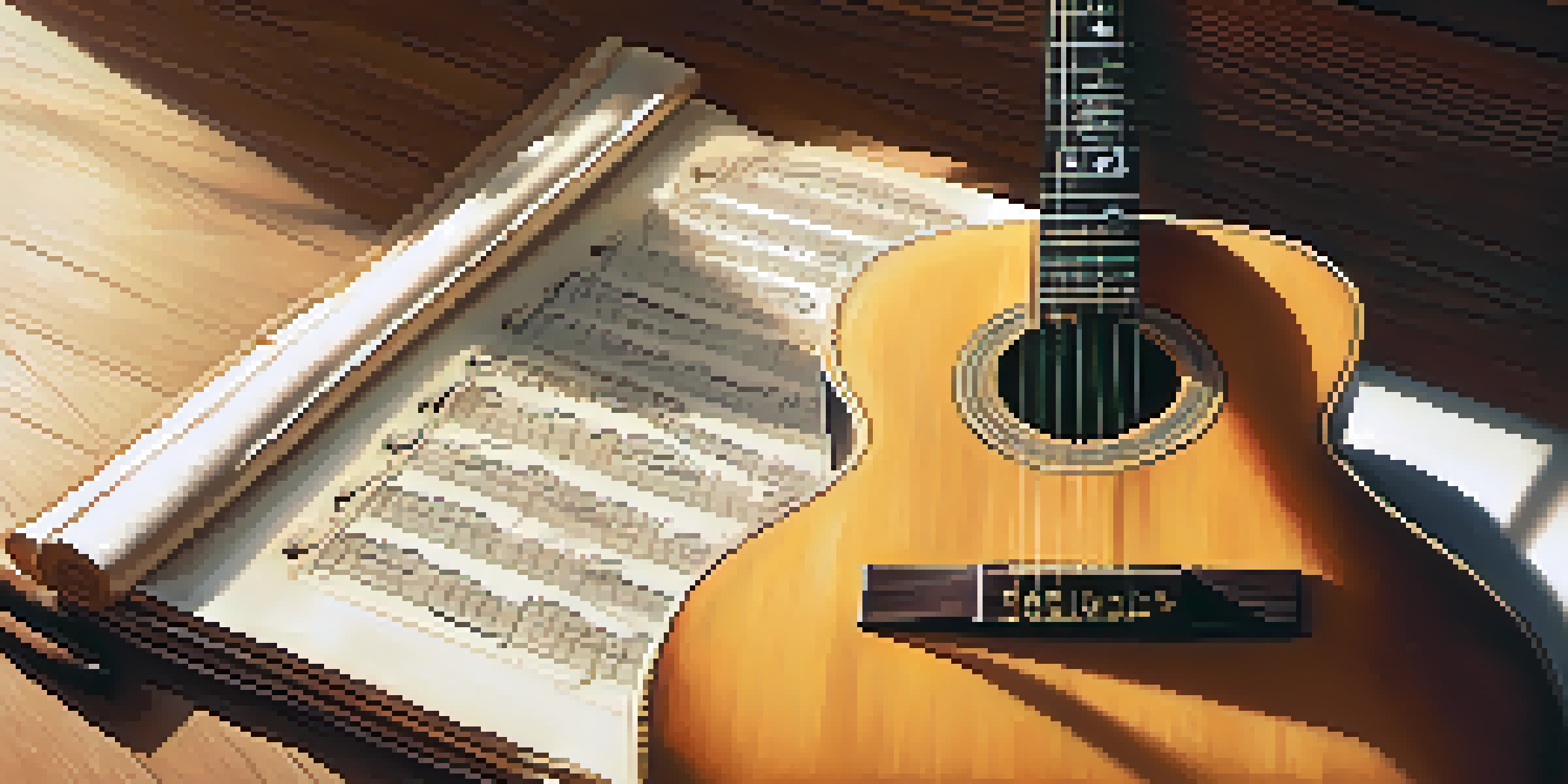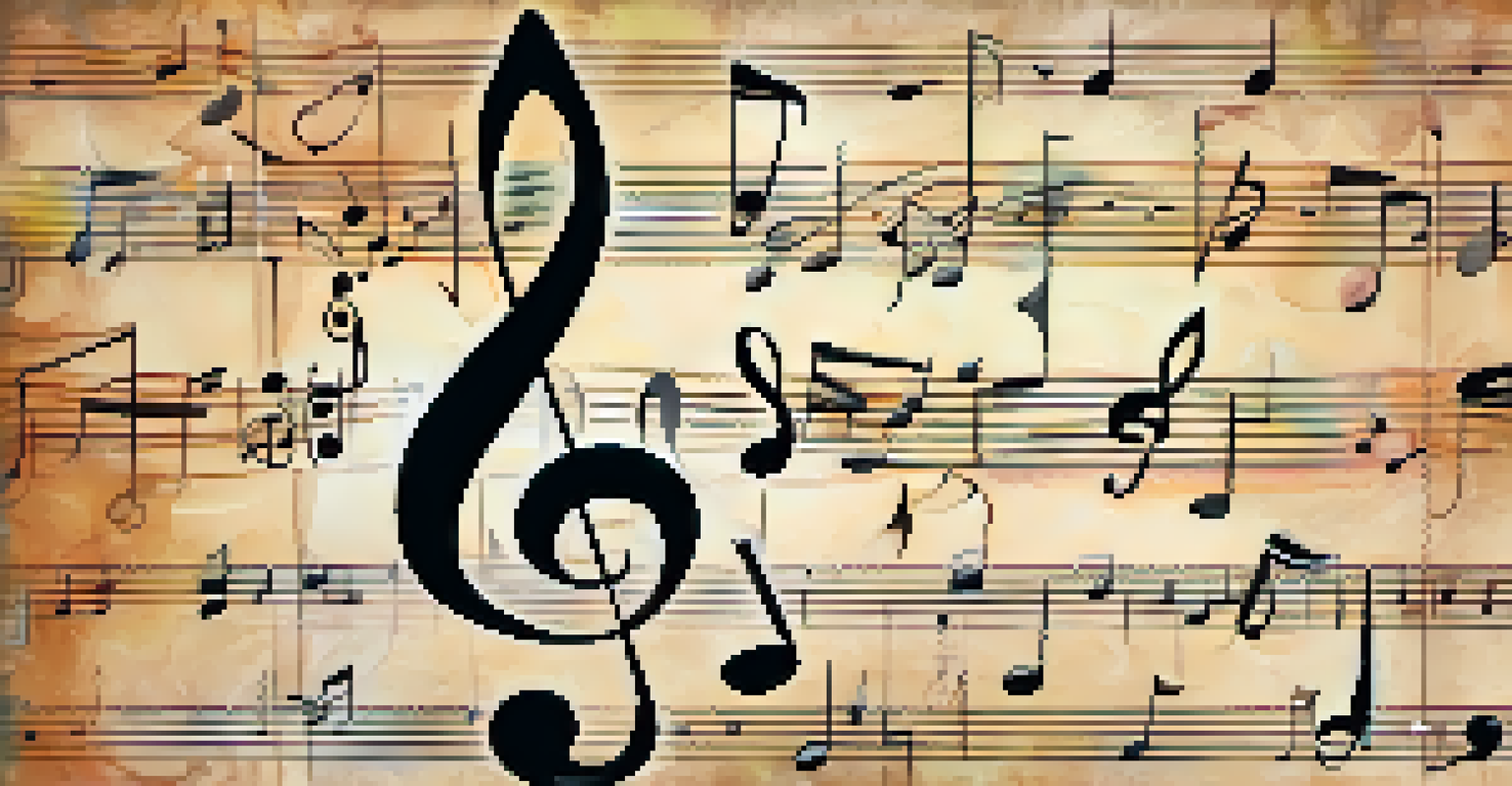The Role of Clefs in Guitar Music Notation Explained

What is a Clef and Why is it Important?
A clef is a musical symbol placed at the beginning of a staff to indicate the pitch of the notes. In guitar music notation, the most common clef is the treble clef, which helps guitarists read higher-pitched notes easily. Understanding clefs is crucial for musicians, as they provide context and clarity in reading music.
Music is the shorthand of emotion.
Without a clef, notes would be ambiguous, making it challenging to play the correct pitches. Just like a map needs a legend to guide you, clefs serve as the key to understanding musical notation. They ensure that the musician can quickly identify the range and type of instrument being played.
In summary, the clef not only simplifies reading music but also enriches the overall musical experience. Knowing the role of clefs can empower guitarists to tackle more complex pieces with confidence. This foundational knowledge is what makes the clef an essential element in music notation.
Types of Clefs Used in Guitar Music
While the treble clef is predominant for guitarists, there are other clefs like the bass clef and alto clef used in different contexts. The bass clef, for instance, is primarily found in music for lower-pitched instruments, while the alto clef is often used for instruments like the viola. Each clef serves a specific purpose and helps musicians understand the pitch range of different instruments.

In guitar music, the treble clef allows players to read notes above the middle C, which is where most guitar melodies reside. This is similar to how a singer might use different vocal ranges; the treble clef ensures that guitarists can effectively communicate their musical ideas. By recognizing the clef used, players can quickly adapt to different styles and genres.
Understanding Clefs is Essential
Clefs are crucial for musicians as they provide clarity and context for reading music, much like a map's legend.
Ultimately, familiarizing yourself with various clefs can broaden your musical horizon. It opens up opportunities to collaborate with other musicians and play diverse pieces. Understanding these differences enhances your skills and allows for greater versatility in performance.
How Clefs Influence Guitar Tablature
Guitar tablature, or 'tab,' is a visual representation of music specifically designed for guitarists. Unlike standard notation, which uses clefs and staffs, tablature uses numbers on lines to indicate which fret to play. However, understanding how clefs relate to standard notation can still inform how you interpret tab, especially when reading sheet music that accompanies it.
The beautiful thing about learning is that no one can take it away from you.
For instance, when a piece of music features both standard notation and tablature, knowing which clef is in use helps you understand the pitch and rhythm. If the treble clef is present, you can assume the notes are intended for higher registers, guiding your finger placements on the fretboard. This connection can be particularly useful when you're learning a new piece or trying to recall a favorite song.
In this way, clefs enrich your overall understanding of music, enabling you to switch between standard notation and tablature seamlessly. This flexibility is vital for guitarists, as it allows for greater creativity and expression. By being adept in both formats, you can enhance your playing and communication with fellow musicians.
Reading Guitar Music with Clefs: A Beginner's Guide
For beginners, learning to read guitar music with clefs can seem daunting, but it’s a valuable skill. Start by familiarizing yourself with the treble clef, as it’s primarily used for guitar music. Take time to practice identifying notes on the staff, associating them with their corresponding frets on the guitar neck.
A helpful approach is to break down the staff into segments, focusing on a few notes at a time. For example, the lines of the treble clef represent E, G, B, D, and F, while the spaces represent F, A, C, and E. With practice, you’ll find that associating these notes with their positions on the guitar becomes second nature.
Treble Clef Dominates Guitar Music
The treble clef is the primary clef used in guitar music, allowing players to read higher-pitched notes effectively.
As you progress, don’t hesitate to use visual aids like flashcards or apps that reinforce your learning. The more you expose yourself to reading music, the more comfortable you’ll become. Remember, every expert was once a beginner; with patience and practice, you’ll master reading guitar music with clefs.
The Connection Between Clefs and Guitar Techniques
The clef you read can influence your playing techniques on the guitar. For example, if you encounter a piece written in the treble clef, you might use techniques like fingerpicking or hammer-ons to express the melody beautifully. Understanding the clef sets the stage for interpreting the music in a way that captures its intended style.
Moreover, certain techniques may be more suited to specific clef contexts. For instance, if a passage requires a lot of quick, high notes, knowing it's in the treble clef might lead you to employ faster picking techniques. This awareness can enhance your performance and help convey the emotion of the piece more effectively.
In essence, the relationship between clefs and guitar techniques is an important aspect of musical expression. By remaining mindful of this connection, you can tailor your approach to playing, making your performances more engaging. This adaptability is key to becoming a versatile guitarist.
How Clefs Aid in Composing Guitar Music
For guitarists who compose their own music, understanding clefs is essential. When you write music in the treble clef, you can effectively communicate your ideas to other musicians, ensuring they interpret your work as intended. This clarity can make collaboration smoother, whether you’re jamming with friends or recording in a studio.
Additionally, knowing how to read and write in the proper clef helps you experiment with different musical styles. For instance, if you’re writing a piece that requires a lower register, being familiar with the bass clef can expand your creative possibilities. This versatility in composition allows you to explore various genres and influences.
Clefs Enhance Composing Skills
Mastering clefs not only aids in reading music but also expands a guitarist's ability to compose and collaborate with others.
Ultimately, mastering clefs not only improves your music-reading skills but also enhances your songwriting abilities. By understanding how to effectively use clefs, you can unlock new dimensions in your compositions, leading to more impactful music. This knowledge is an invaluable asset for any aspiring guitarist.
Practicing with Clefs: Tips for Guitarists
To become proficient in reading and interpreting clefs, regular practice is key. Set aside dedicated time each week to focus on sight-reading pieces in the treble clef. Start with simple melodies and gradually work your way up to more complex compositions, ensuring that you’re building your skills incrementally.
Incorporating apps and online resources can also enhance your practice sessions. Many platforms offer interactive exercises tailored to help you master clefs and reading music. This technology can make learning more engaging and allow you to track your progress over time.

Lastly, consider playing with other musicians who read music. Collaborating with others can provide valuable insights and help reinforce your understanding of clefs in a practical setting. The more you immerse yourself in reading and playing, the more naturally it will come to you.